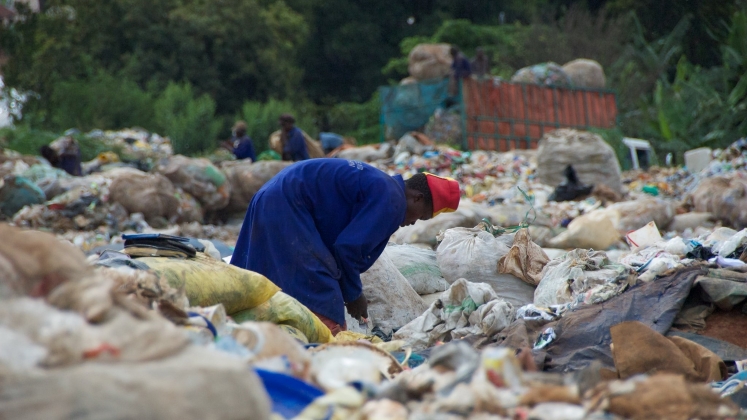In The Infrastructural South: Techno-Environments of the Third Wave of Urbanization, Jonathan Silver explores infrastructural evolution in the Global South, extrapolating from case studies in urban sub-Saharan Africa. Taking a broad interdisciplinary view, the book effectively shows how technology, inequality, climate change and private versus public investment shape contemporary infrastructural landscapes, writes Dagna Rams.
 When delving into developmental reports about infrastructure in Africa, one stumbles upon assessments that it is “lagging behind” or “missing”. While it might be easy to point to “infrastructural gaps” and sigh at the scale of what is to be done, it is more difficult to understand what is actually happening, why, and with what consequences. Jonathan Silver’s Infrastructural South: Techno-Environments of the Third Wave of Urbanization is the author’s attempt to conceptualise African infrastructures, focusing on the abundance of processes on the ground. Silver pays attention to the private investment being pumped into the continent, the government’s infrastructural spending, and the multiple individual and collective efforts to make the city work. The book is panoramic, using case studies from sub-Saharan urban Africa to extrapolate to the “Global South”. Its value comes from explaining how key trends such as growing inequalities, climate change and digital economies affect infrastructures, creating new path dependencies embedded in their material networks.
When delving into developmental reports about infrastructure in Africa, one stumbles upon assessments that it is “lagging behind” or “missing”. While it might be easy to point to “infrastructural gaps” and sigh at the scale of what is to be done, it is more difficult to understand what is actually happening, why, and with what consequences. Jonathan Silver’s Infrastructural South: Techno-Environments of the Third Wave of Urbanization is the author’s attempt to conceptualise African infrastructures, focusing on the abundance of processes on the ground. Silver pays attention to the private investment being pumped into the continent, the government’s infrastructural spending, and the multiple individual and collective efforts to make the city work. The book is panoramic, using case studies from sub-Saharan urban Africa to extrapolate to the “Global South”. Its value comes from explaining how key trends such as growing inequalities, climate change and digital economies affect infrastructures, creating new path dependencies embedded in their material networks.
[The book’s] value comes from explaining how key trends such as growing inequalities, climate change and digital economies affect infrastructures
What is “third wave urbanisation” and what forms of infrastructures does it give rise to? What are the “techno-environments”? And how far does the “infrastructural south” reach? The jargon already present in the title foretells the author’s commitment to pair analysis with the coinage of new terms – at least one in almost every chapter. Their persuasiveness depends on their usefulness and ability to travel to other contexts far and wide.
Silver appropriates “third-wave urbanism” for the African context. Geography scholars might associate the term with its use to describe urbanisation propelled by the “knowledge” or “cognitive-cultural” economy – a process that moves cities away from their industrial past towards gentrification, impersonal office buildings and consumption based on lifestyle. Although never fully spelled out, the book tacitly situates the third wave after the colonial city-making which created racial and territorial divisions within cities (first wave?) and the independence-era modernisation and industrialisation that saw the building of some public housing (second wave?). The third wave is characterised by a dizzyingly rapid rise of the urban population amid the demise of the hitherto limited opportunities within the public and industrial sectors. The cities are landscapes of manifest inequality, most starkly between informal labour and the elites connected to extractive industries. Given the preponderance of these urban trends across the continent, the author sets out to explore the infrastructural outcomes they bring forth, or the condition of the “Infrastructural South”.
Private cities of Appolonia City outside Accra and Eko Atlantic outside Lagos […] represent new transfers of capital – from Asia and Russia – and ‘start again’ urbanisation for the ‘middle class’
The “Infrastructural South” is foremost characterised by different “techno-environments,” that is, infrastructural worlds characterised by distinct technological arrangements that alter environments. The most extreme examples of such “techno-environments” are the uncompleted but already materially present private cities of Appolonia City outside Accra and Eko Atlantic outside Lagos. They represent new transfers of capital – from Asia and Russia – and “start again” urbanisation for the “middle class”, promising a lack of congestion and reliable infrastructure. In contrast to these – still only – fantasies, ever more urban residents club to sprawling suburban neighbourhoods where houses precede infrastructure, and the latter is left for the people to figure out. “Techno-environment” is a useful coinage, especially amid climate change, when the extent to which people can harness the environment for their own projects or be exposed to its whims creates new social distinctions and a looming “eco-segregation” (56). Besides these, the book covers other transversal trends such as the development of “corridors” to increase infrastructural efficiency around areas of direct relevance to extractive industries or “disruptions,” that is, infrastructures created by technologies imposing new designs like Uber or harnessing what exists with the aim of making it more efficient like creating an app for booking an existing bus service.
The “Infrastructural South” is a condition that can be found anywhere
Though case studies from sub-Saharan Africa and three cities – Accra, Cape Town and Kampala – form the backbone of this study, the author emphasises that the “Infrastructural South” is a condition that can be found anywhere. To that point, the final pages look at the water pollution in Flint, Michigan and Camden, New Jersey as examples of the “Infrastructural South”. Here, like in other places visited in the book’s pages, much more is happening than a simple lack of money that drives a lack of infrastructure. For example, schools are given funding to buy bottled water for pupils to compensate for polluted tap water, and though fixes such as this are meant to be temporary, they create lasting path dependencies. Only some of the problems get addressed and the outcomes are variable (eg, while at school, kids do not drink polluted water, but may do so at home, especially if their parents are poor). The “Infrastructural South” is thus a condition of half-measures, half-funded, half-improvements that outsource ever more responsibilities onto the people and the private sector, undermining the promise of a “public” commonly associated with infrastructural investment.
The undeniable strength of the book is its ability to identify infrastructural trends and point in the direction of new research paths
The undeniable strength of the book is its ability to identify infrastructural trends and point in the direction of new research paths. Given the book’s reliance on case studies from the anglophone world, and specifically, destinations that attract financial capital such as Accra or Cape Town, there is also an important question about how the trends it identifies play out in other parts of the continent. In addition, the book strikes me as a particularly suitable introduction to the topic of infrastructure in urban Africa for interdisciplinary contexts, especially where students have had less exposure to post-colonial theory or critical urban studies.
Because of the broad scope of the research, the examples it uses – waste companies, public toilets, electricity solutions, private cities, and corridors – are outlined rather than explored in depth. The methodology relies on reports in the public domain and short visits to different infrastructural sites. The author states in relation to each visit whether he gave notice or arrived spontaneously, suggesting that the latter allowed him to pierce through appearances. One aspect in which the book leaves a reader wanting is with regards to the many people – infrastructure users and workers – who populate the pages: they are mentioned by first name alone and we learn very little about them other than the fact that their utterances support the author’s arguments. Given the number of people mentioned, I had a sense that the “Infrastructural South” is populated by crowds from Ablade Glover’s paintings – a multitude who are seen from enough of a distance to appear to be speaking in one voice, which does not chime with the picture of infrastructural inequalities and individualised strife otherwise represented in the author’s theory.
The durability of infrastructure means that it can have the power to define cities for years to come
The durability of infrastructure means that it can have the power to define cities for years to come, just as inequalities solidified in colonial infrastructures have defined contemporary urban fabric. Likewise, decisions made today can alter urban maps in ways that will be difficult to undo – a proposition that is especially consequential in the context wherein climate change preparedness plans emphasise the importance of resilience and adaptability. Infrastructures matter. As Silver’s book warns, it is important to interrogate whether the infrastructures touted, established and planned are meant to connect or disconnect urban populations, whether the material arrangements they create are based on solutions that see into the future of the public or fixes that favour private investment. The resounding worry of the book is that the latter is likelier, and that tendency is not only prevalent in urban Africa or even the Global South, but the world over.
This post gives the views of the author, and not the position of the LSE Review of Books blog, or of the London School of Economics and Political Science.
Image Credit: Kehinde Temitope Odutayo on Shutterstock.







